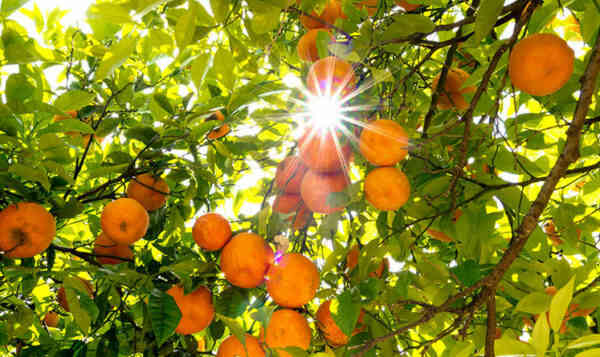Juicy and tasty oranges are ubiquitous, and there are a huge number of their varieties in the world. They are grown on all continents, and are in constant demand – they are eaten fresh, put in salads, used to produce drinks and jams, and in general, they just don’t do anything with them. The huge popularity of oranges has led to the fact that breeders produce many new varieties of them every year, as well as cross them with other citrus fruits, getting completely new fruits.
Interesting facts about oranges
- The sour orange was first brought to Europe by Portuguese navigators around the 10th century, while the sweet orange was only introduced to Europe in the 15th century by Genoese traders.
- It is illegal to eat oranges while taking a bath in California.
- Ripe oranges are green in tropical climates and orange in temperate climates.
- Bobby Leach, the first man to cross the Niagara Falls in a barrel, died after slipping on an orange peel, injuring his leg and developing gangrene as a result (interesting facts about waterfalls).
- About 20 percent of all oranges grown in the world are sold and consumed as fresh fruit. The rest goes to the production of juices, extracts and preserves.
- Orange ranks first in the world in terms of the weight of the crop harvested annually. In second place is a banana.
- Oranges protect against premature aging. This fruit received the ability to prolong youth due to the content of a biologically active compound called narigenin.
- The most common citrus in the world is the orange.
- About 35 million orange trees grow in Spain (interesting facts about Spain).
- There are about six hundred varieties of oranges in the world, but new ones are regularly introduced.
- Some orange trees live for a hundred to one hundred and fifty years.
- Oranges help you lose weight. The combination of low fat content and high fiber content makes the orange an excellent product for weight loss.
- Argentina has developed a special cargo plane to transport oranges. The model was named “Naranjero”, which means “orange” in Spanish.
- Brazil is the world’s first producer of oranges.
- After chocolate and vanilla, orange is the third most loved flavor in the world (interesting facts about chocolate).
- Special glass structures have been built to grow oranges in Europe. And since oranges were called “orange”, the facilities for growing them were called greenhouses.
- Oranges are good for the heart. The large amount of potassium and calcium contained in this fruit has a beneficial effect on heart rate and heart muscle health.
- Orange juice is the most popular in the world.
- According to FDA standards, one glass of orange juice can contain up to ten fruit fly eggs and up to two fruit fly larvae. Redesigned, of course.
- Oranges are good for eyesight. The orange color of these sunny fruits is a signal that, like carrots, they contain large amounts of vitamin A, which is good for eye health (interesting facts about eyes and vision).
- American advertisers have invented a new superhero , Captain Citrus, to sell more orange juice.
- Moro oranges are also called red or blood oranges. This variety got its name because of the blood-red color of the pulp.
- Botanists attribute the fruit of the orange tree to berries.
- In Afghanistan, oranges are commonly used as a condiment for meals. They are cut in half and juiced directly into fried dishes – it is believed that this helps to digest fatty foods faster. And in Jamaica, they wash the floors with the help of oranges. The principle is the same as in Afghanistan – orange juice cleanses fat and oil well.
- A large orange tree can bear up to forty thousand fruits a year.
- Orange peel lowers blood sugar levels. Orange peel contains the substance pectin, a natural dietary fiber that prevents stomach problems and maintains the necessary level of sugar in the blood (interesting facts about human blood).
- Sticks made from orange tree wood are used in manicure and pedicure, as they are characterized by a combination of density and at the same time softness.
- Washington Navel oranges do not have seeds, and therefore cannot reproduce by pollination and are reproduced only by grafting.
- One orange tree can have up to 60,000 flowers, but only 1% of them will eventually develop fruit.
- You have to eat 7 bowls of corn flakes to get as much fiber as one orange.
- Valencia oranges are the most common variety in the world.
- In the city of Odessa there is a monument to an orange.
- Several trees can grow from one orange seed.
- The famous «golden apples» from ancient Greek legend – this is exactly this fruit.
- The smallest relative of the orange is the kumquat, known in Europe as «dwarf orange». It is noteworthy that this type of citrus fruit has a pronounced anti-alcohol effect. For example, in Vietnam it is customary to relieve a hangover by eating a few kumquats. Also, many kumquats grow in Greece, especially on the islands of Crete, Rhodes and Corfu (interesting facts about Crete).
- In a number of cultures, oranges are considered a symbol of fertility – a lush growing evergreen orange tree blooms, bears fruit and blooms leaves at the same time.
- The crown of some specimens of orange trees is comparable in size to the crowns of mighty oaks.
- One orange contains the daily requirement of vitamin C for an average adult.
- For the first time, “cultivated” orange trees began to be grown in Ancient China (interesting facts about Ancient China).
- In the 18th century, British sailors, in addition to sauerkraut, took oranges with them on ships so as not to get sick with scurvy, but they were usually salted for greater safety.
